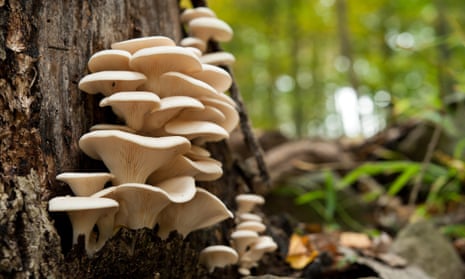In a few days the car parks of Epping Forest will once again bristle with warnings about the criminal consequences of fungi foraging. A similar campaign appeared in the New Forest last week, in this case a first for the national park. Remove a single mushroom from these parks and you now face prosecution. The mushroom-picking season is upon us, but this year the autumnal ritual is being accompanied by unusually high levels of anxiety.
Until this month the New Forest National Park Authority permitted individuals to gather up to 1.5kg of mushrooms for their own use. Commercial collection was banned outright. But now it has decided to follow up the example of Epping Forest, which banned all gathering of fungi several years ago.
Just how much damage will be inflicted by those who flout the bylaws remains to be seen. In recent years our forests have been assailed by gangs of pickers who in a few hours can strip the land of hundreds of kilograms of oyster, chanterelle, field, cep and other mushrooms just to satisfy the nation’s growing urge to forage for food.
“We had a quiet year in 2015 because we had a relatively poor crop of fungi, a consequence of the weather at the time,” said Jeremy Dagley, head of conservation for Epping Forest. “On the other hand, this year we could get a bumper crop. Who knows what kind of foraging – and damage – we will experience then?”
Twenty years ago, no commercial fungi foraging was carried out in Britain. By 2013 it had risen to such a scale that there were 20 successful prosecutions for illegal fungi-picking in Epping Forest alone, with one person being caught with 20 sacks of mushrooms. Those found guilty were fined sums of around £200.
But many foragers insist that their handiwork does no harm. Carried out in a responsible manner, it causes no damage. It is the equivalent of the blackberry gathering that many families enjoy at this time of year, they argue.
But this is rejected by fungi expert Professor Lynne Boddy, of Cardiff University. “People say picking fungi is just like picking blackberries off a bush. But it is not,” she said. “Plants like the blackberry bush evolved to produce fruit that contain their seeds, which birds and animals eat and transmit through their droppings. These berries exist to spread seeds.”
By contrast, most fungi transmit their spores in the wind. If they are gathered in plastic bags, the spores can no longer spread, reducing the genetic diversity of populations of fungi in a woodland area. “Certainly fungi-gathering is not like fruit-picking and it is false to claim so,” Boddy added.

In fact, fungi are incredibly important to the planet, Boddy argued. “Earth’s ecosystems would not work without fungi. They decompose wood and plant tissue; break down dead stuff and recycle nutrients; and grow into plant roots, carrying water and nutrients into them. Without them most plants would not survive. So anything that encourages people to go out and look at fungi is good, as far as I am concerned.”
The problem was that foragers were now gathering up fungi on such a vast scale that they could inflict severe damage, Boddy said. They often ripped up other plants and trampled down the undergrowth, thus destroying important habitats for insects and other species. In addition, in many cases fungi gatherers had no knowledge of what they were digging up.
“They can be completely indiscriminate,” said Dagley. “They rip up everything and then, later on, discard what they don’t want. But that often means destroying quite fragile rare but inedible fungi for no good reason at all. At the same time, these fungi are often very beautiful to look at and are a real attraction for the visitors to the forest at this time of year. That is one reason why we have introduced our ban.”
This point was backed by Boddy. “These foragers are like bottom-trawling dredgers that rip up the seabed in search of shellfish. They do incredible damage. I think the concerns of the New Forest and other areas of special scientific interest are quite justifiable.”
Oliver Crossthwaite-Eyre, chairman of the New Forest National Park Authority, said: “Leaving fungi unpicked means they continue to contribute to the forest’s fragile ecosystem. This is an important and decisive move because the New Forest is a stronghold for many rare and endangered species of fungi.”
But the danger to the environment is not the only problem raised by the increased popularity of fungi foraging. In addition to the record amount of wild mushrooms that were gathered in 2014, there was also a noticeable number of poisoning cases reported by Public Health England. A total of 84 cases of wild-mushroom poisoning were reported just a month into the foraging season, it was revealed in early October that year. A similar figure could be experienced this year.
One of the deadliest fungi is the innocent-looking death cap mushroom. An ounce of this fungus can kill. In 2013 a Somerset woman suffered multiple organ failure and died after eating soup to which she had added death cap mushrooms she had found growing in her garden and assumed were edible.
Other fungi have less toxic effects but can nevertheless cause illness. “Some fungi look awfully like normal mushrooms but are actually poisonous,” said Dagley. “There is one called yellowstainer, which look the normal mushroom with brown gills that you buy in a supermarket. However, it can really upset your stomach.
“Then there is chicken-of-the-wood mushroom that grows on trees. Guidebooks sometimes say this is edible, but people respond in different ways to it and you can get an extremely nasty stomach upset from eating it – even though it is said to be edible. You really have to know what you are doing.”

Comments (…)
Sign in or create your Guardian account to join the discussion